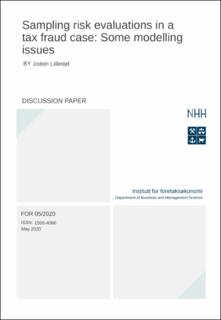| dc.description.abstract | This work is a follow-up to Lillestøl (2019). The context is the use of sample data to support claims of tax fraud at eateries, where the possibilities of embezzlement are overreporting of take-away sales and underreporting of cash payments. Ratios of sales amounts of opposing types are computed from the sample and used as estimates for the true yearly ratios. Decisions are made by comparison with the reported ratios in the taxpayer’s yearly income statement, allowing for sampling risk. To this end, a “risk distribution” is established and its quantiles used as decision limits. There are different ways of doing the calculation and to establish the accompanying risk distribution, among them models based on Gamma-assumptions, as detailed in Lillestøl (2019). They may lead to different results, more or less favorable to the taxpayer. The chosen method therefore must be fair and defensible. In this connection, some relevant issues have surfaced, mainly related to independence and conditioning. The objective of this paper is to explore these issues and provide some recommendations on the choice of method. | en_US |
